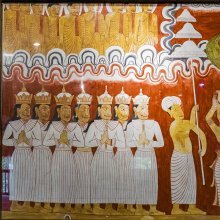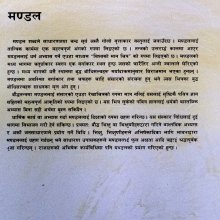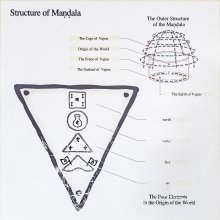Madhyama, Mādhyama: 35 definitions
Introduction:
Madhyama means something in Buddhism, Pali, Hinduism, Sanskrit, Jainism, Prakrit, the history of ancient India, Marathi, Hindi. If you want to know the exact meaning, history, etymology or English translation of this term then check out the descriptions on this page. Add your comment or reference to a book if you want to contribute to this summary article.
Images (photo gallery)
In Hinduism
Natyashastra (theatrics and dramaturgy)
Source: Wisdom Library: Nāṭya-śāstra1) Madhyama (मध्यम) refers to the fourth of the seven “musical notes” (svara), according to the Nāṭyaśāstra chapter 6, chapter 19 and chapter 28. These seven notes are part of the ‘vocal representation’ (vācika), which is used in communicating the meaning of the drama and calling forth the sentiment (rasa). The seven notes (svara) are to be used in different sentiments (rasa). For example, madhyama and pañcama are to be used in the heroic (vīra), the furious (raudra) and the marvellous (adbhuta) sentiment.
The presiding deity of the madhyama musical note (svara) is defined by various sources:
Nāradīyā-śīkṣā 1.5.13-14 mentions that the madhyama note is sung by Viṣṇu.
Bṛhaddeśī 75-76 mentions Śiva as the presiding deity of madhyama.
Saṅgītaratnākara 1.3.57-58 mentions Śiva as the presiding deity of madhyama.
Saṃgītamakaranda 1.1.38, Idem.
Cf. Saṃgītarāja 2.1.1.264.
The following animal sounds are associated with this note:
Nāradīyā-śīkṣā 1.5.3 assigns this note to the cry of the curlew (krauñca).
Bṛhaddeśī 64, p13, 2.1-5, Idem.
Saṃgītamakaranda 1.1.13, Idem.
Saṅgītaratnākara 1.3.4.6, Idem.
Cf. Saṃgītarāja 2.1.1.212.
2) Madhyama (मध्यम) refers to one of the jātis (melodic class) related to the madhyama-grāma, according to the Nāṭyaśāstra chapter 28. It is therefore also known as madhyamajāti. Jāti refers to a recognized melody-type and can be seen as a precursor to rāgas which replaced them.
According to the Nāṭyaśāstra 28.128-130, “in the madhyama-jāti the aṃśa (key note) is ṣaḍja, ṛṣabha, madhyama, pañcama and dhaivata, and they are the apanyāsa (semi-terminal note), and the nyāsa (terminal note) is madhyama. The two notes of two śrutis (i.e, gāndhāra and niṣāda) are to be weakened, and its pentatonic treatment (auḍava / auḍavita) excludes gāndhāra and niṣāda, while its hexatonic treatment (ṣāḍava / ṣāḍavita) excludes gāndhāra. In it the amplification (bahutva) of ṣaḍja and madhyama, and weakness (alpatva, reduction) of gāndhāra have been prescribed”.

Natyashastra (नाट्यशास्त्र, nāṭyaśāstra) refers to both the ancient Indian tradition (shastra) of performing arts, (natya—theatrics, drama, dance, music), as well as the name of a Sanskrit work dealing with these subjects. It also teaches the rules for composing Dramatic plays (nataka), construction and performance of Theater, and Poetic works (kavya).
Purana and Itihasa (epic history)
Source: Wisdom Library: PurāṇasMadhyama (मध्यम, “middling”) refers to a classifications of maṇḍapa (halls attached to the temple), according to the Matsya-purāṇa (verses 270.1-30). The Matsyapurāṇa is one of the eighteen major purāṇas dating from the 1st-millennium BCE.
Source: archive.org: Shiva Purana - English TranslationMadhyamā (मध्यमा) refers to the “middling” division of chaste ladies, according to the Śivapurāṇa 2.3.54 (“Description of the duties of the chaste wife”).—Accordingly, as a Brahmin lady said to Pārvatī: “[...] O gentle lady, the chaste ladies can be divided into four classes. Even when they are remembered they dispel sins. The divisions comprise of the superior etc. They are superior, middling (madhyamā), inferior and very inferior. I shall explain their characteristics. Listen with attention. [...] O daughter of the mountain, she who sees another man as her father, brother or son with a clean conscience is the middling (madhyamā) among chaste ladies. [...]”.
Source: Cologne Digital Sanskrit Dictionaries: The Purana Index1a) Madhyama (मध्यम).—The eighteenth kalpa; the beginning of madhyama svara.*
- * Vāyu-purāṇa 21. 38.
1b) A name of a svara sacred to Dhaivata.*
- * Va. 21. 39.
Madhyama (मध्यम) is a name mentioned in the Mahābhārata (cf. XIV.8.19, XIV.8) and represents one of the many proper names used for people and places. Note: The Mahābhārata (mentioning Madhyama) is a Sanskrit epic poem consisting of 100,000 ślokas (metrical verses) and is over 2000 years old.

The Purana (पुराण, purāṇas) refers to Sanskrit literature preserving ancient India’s vast cultural history, including historical legends, religious ceremonies, various arts and sciences. The eighteen mahapuranas total over 400,000 shlokas (metrical couplets) and date to at least several centuries BCE.
Shiksha (linguistics: phonetics, phonology etc.)
Source: Google Books: Dattilam: A Compendium of Ancient Indian Music [shiksha]Madhyama (मध्यम) refers to the fourth of six notes (svara) in Indian music.—The essence of madhyama is in the air, which, rising from the navel, striking the chest and the heart, reaches the navel as a big sound. (Nāradīyā-śikṣā 1. 5.7-11)
Shiksha (शिक्षा, śikṣā) deals with Sanskrit linguistics and represents a branch of vedanga (vedic ancillary science). Shiksha deals with subjects such as phonetics, phonology, study of sound, letters of the Sanskrit alphabet and related topics. Much attention is also given to the study of recitation (patha) of Vedic verses.
Shilpashastra (iconography)
Source: archive.org: Illustrations of Indian Music and Dance in Western Indian StyleMadhyama (मध्यम).—Illustration of the madhyama-svara according to 15th century art.—The colour of the body of madhyama-svara is yellow like gold. He has four hands. His upper right hand is in the varada-mudrā; and lotus is in his left hand; in lower right hand there is a jar (kalaśa) and in the left hand a vīṇā (Indian lute). His vehicle is a Krauñca bird. The colour of his scarf is green with a black design and the colour of the lower garment is rosy with a red design.
The illustrations (of, for example Madhyama) are found scattered throughout ancient Jain manuscripts from Gujarat. The descriptions of these illustrations of this citrāvalī are based on the ślokas of Vācanācārya Gaṇi Sudhākalaśa’s Saṅgītopaniṣatsāroddhāra (14th century) and Śārṅgadeva’s Saṅgītaratnākara (13th century).

Shilpashastra (शिल्पशास्त्र, śilpaśāstra) represents the ancient Indian science (shastra) of creative arts (shilpa) such as sculpture, iconography and painting. Closely related to Vastushastra (architecture), they often share the same literature.
Arthashastra (politics and welfare)
Source: Shodhganga: Kakati Ganapatideva and his times (artha)Mādhyama refers to “intermediary situated close to the conqueror and the latter’s immediate enemy” and represents one of the twelve categories of the maṇḍala system laid out by Kauṭilya (4th century BCE) and Kāmandaka (7th century A.D.). These twelve cateogires of state can be broadly applied to Gaṇapatideva (r. 1199-1262 A.D.) and the Kākatīya empire.—The Telugu Coḍas of Nellore are an example of Mādhyama.

Arthashastra (अर्थशास्त्र, arthaśāstra) literature concerns itself with the teachings (shastra) of economic prosperity (artha) statecraft, politics and military tactics. The term arthashastra refers to both the name of these scientific teachings, as well as the name of a Sanskrit work included in such literature. This book was written (3rd century BCE) by by Kautilya, who flourished in the 4th century BCE.
Vyakarana (Sanskrit grammar)
Source: Wikisource: A dictionary of Sanskrit grammar1) Madhyama (मध्यम).—The middle person (मध्य-मपुरुष (madhya-mapuruṣa)), cf. युष्मद्युपपदे (yuṣmadyupapade)...मध्यमः (madhyamaḥ) P. I. 4.105; cf. also Nir. VII. 7;
2) Madhyama.—Middling tone or effort cf. मध्यमेन स वाक्ययोगः (madhyamena sa vākyayogaḥ) T. Pr. XVIII. 4, where the commentator explains the word as उच्चनीचसमाहारविलक्षणः वाक्प्रयोगः । (uccanīcasamāhāravilakṣaṇaḥ vākprayogaḥ |) the word मध्यमा (madhyamā) is used in this sense as qualifying a mode of utterance. वृत्ति (vṛtti); cf. अभ्यासार्थे द्रुतां वृत्तिं प्रयोगार्थे तु मध्यमाम् । (abhyāsārthe drutāṃ vṛttiṃ prayogārthe tu madhyamām |) Ṟ. Pr. XIII. 19; cf also चतुष्कला मध्यमायार्म् (catuṣkalā madhyamāyārm) R. T. 32;
3) Madhyama.—One of the seven modes of speech or tones. cf सप्त वाचः स्थानानि भवन्ति । उपांशुध्वान-निमदेपव्दिमन्मन्द्रमध्यमताराणि (sapta vācaḥ sthānāni bhavanti | upāṃśudhvāna-nimadepavdimanmandramadhyamatārāṇi) T. Pr. XXIII.4 and 5 and also कण्ठे मध्यमम् (kaṇṭhe madhyamam) XVIII.11 where the commentatator explains मध्यम (madhyama) as यत्र कण्ठे स्थाने प्रयोग उपलभ्यते तन्मध्यमं नाम षष्ठं वाचस्स्थानम् । (yatra kaṇṭhe sthāne prayoga upalabhyate tanmadhyamaṃ nāma ṣaṣṭhaṃ vācassthānam |)
4) Madhyama.—One of the seven musical notes originating or proceeding from the Svarita accent cf., स्वरित-प्रभवा ह्येते षड्जमध्यमपञ्चमाः (svarita-prabhavā hyete ṣaḍjamadhyamapañcamāḥ) Pāṇ Śikṣā.
--- OR ---
Madhyamā (मध्यमा).—(or मध्यमवृत्ति (madhyamavṛtti)) See मध्यम (madhyama) (2).

Vyakarana (व्याकरण, vyākaraṇa) refers to Sanskrit grammar and represents one of the six additional sciences (vedanga) to be studied along with the Vedas. Vyakarana concerns itself with the rules of Sanskrit grammar and linguistic analysis in order to establish the correct context of words and sentences.
Pancaratra (worship of Nārāyaṇa)
Source: archive.org: Isvara Samhita Vol 5Madhyamā (मध्यमा).—Parā, Paśyantī, Madhyamā and Vaikharī are the four stages through which sounds pass through before they become audible. At first, it is in the form of air. Then it teaches the stage of Paśyantī. The next stage is called Madhyamā (Kal P. 182) and the last one is Vaikharī where it is uttered, tridhā: into three.

Pancaratra (पाञ्चरात्र, pāñcarātra) represents a tradition of Hinduism where Narayana is revered and worshipped. Closeley related to Vaishnavism, the Pancaratra literature includes various Agamas and tantras incorporating many Vaishnava philosophies.
Dharmashastra (religious law)
Source: Sacred Texts: The Grihya Sutras, Part 2 (SBE30)Madhyama (मध्यम) refers to a type of tone (coming from the throat), which is used in chanting hyms.—Another [commentator] distinguishes three high tones, the kruṣṭa (also called tāra or krauñca), the madhyama, and the mandra, and assigns the madhyama to the Sāmidhenī hymns. The mandra notes come from the chest, the madhyama notes from the throat, the uttama notes from the head.

Dharmashastra (धर्मशास्त्र, dharmaśāstra) contains the instructions (shastra) regarding religious conduct of livelihood (dharma), ceremonies, jurisprudence (study of law) and more. It is categorized as smriti, an important and authoritative selection of books dealing with the Hindu lifestyle.
Vaishnavism (Vaishava dharma)
Source: Pure Bhakti: Arcana-dipika - 3rd EditionMadhyama (मध्यम) refers to the “intermediate stage”, according to the Arcana-dīpikā (manual on deity worship).—Exalted devotees of Śrī Bhagavān have commented on [Hari-bhakti-vilāsa 11.237] as follows: To become eligible to genuinely enter the chanting of the holy name (nāma-bhajana), the living entity must first be elevated from the kaniṣṭha (neophyte) stage to the madhyama (intermediate) stage, by rendering service to the deity form of the Supreme Lord. The process of deity worship has been mentioned in both the Pañcarātra and the Bhāgavatam.
Source: Pure Bhakti: Brhad BhagavatamrtamMadhyama (मध्यम) refers to:—Intermediate. (cf. Glossary page from Śrī Bṛhad-bhāgavatāmṛta).

Vaishnava (वैष्णव, vaiṣṇava) or vaishnavism (vaiṣṇavism) represents a tradition of Hinduism worshipping Vishnu as the supreme Lord. Similar to the Shaktism and Shaivism traditions, Vaishnavism also developed as an individual movement, famous for its exposition of the dashavatara (‘ten avatars of Vishnu’).
Jyotisha (astronomy and astrology)
Source: Wisdom Library: Brihat Samhita by VarahamihiraMadhyama (मध्यम) refers to “moderate”, according to the Bṛhatsaṃhitā (chapter 8), an encyclopedic Sanskrit work written by Varāhamihira mainly focusing on the science of ancient Indian astronomy astronomy (Jyotiṣa).—Accordingly, “The five years of the eleventh yuga are—1. Piṅgala, 2. Kālayukta, 3. Siddhārtha, 4. Raudra, 5. Durmati. In the first year there will be much rain and fear from thieves and mankind will suffer from consumption of the lungs and the like asthmatic complaints. In the year Kālayukta mankind will suffer from various evils; but in Siddhārtha they will be happy in more ways than one. In the year Raudra mankind will suffer much and there will be loss and ruin in the land. In Durmati there will be moderate rain [i.e., madhyama-vṛṣṭi-kṛt]”.

Jyotisha (ज्योतिष, jyotiṣa or jyotish) refers to ‘astronomy’ or “Vedic astrology” and represents the fifth of the six Vedangas (additional sciences to be studied along with the Vedas). Jyotisha concerns itself with the study and prediction of the movements of celestial bodies, in order to calculate the auspicious time for rituals and ceremonies.
Shaivism (Shaiva philosophy)
Source: Brill: Śaivism and the Tantric TraditionsMadhyamā (मध्यमा) [=madhya?] refers to “(attainment of) middling (siddhis)”, according to the Guhyasūtra chapter 9.—Accordingly, “[...] [The Lord spoke]:—[...] He will be released from [the retributive force of] major transgressions; and he will attain low siddhis after two months, middling Siddhis (madhyamā-siddhi) after half a year and high siddhis after a year; he will attain power over the spell (vidyāsiddhi). The ability to make himself atomic, along with the others [of the Yogic powers], will arise. He will take pleasure in the company of siddhas. He will attain the wishes he desires; if he is without desires, he will attain liberation. [...]”.
Source: SOAS University of London: Protective Rites in the Netra TantraMadhyama (मध्यम) refers to the “middle”, according to the Netratantra of Kṣemarāja: a Śaiva text from the 9th century in which Śiva (Bhairava) teaches Pārvatī topics such as metaphysics, cosmology, and soteriology.—Accordingly, [verse 2.28cd-33]—“Now, I shall explain the limbs of the mantra, with which, tied together, he achieves perfection. The hṛdayamantra, [which] confers all perfections, is the letter that terminates in the middle (kṛtānta-madhyama) [j], followed by the fifth sovereign vowel [u], and summits with the conclusion of wind [ṃ]. The śiras is terminal soma [v] joined with that from anala [y] and yoked with oṃ. [...]”.

Shaiva (शैव, śaiva) or Shaivism (śaivism) represents a tradition of Hinduism worshiping Shiva as the supreme being. Closely related to Shaktism, Shaiva literature includes a range of scriptures, including Tantras, while the root of this tradition may be traced back to the ancient Vedas.
Gitashastra (science of music)
Source: Shodhganga: Elements of Art and Architecture in the Trtiyakhanda of the Visnudharmottarapurana (gita)1) Madhyama (मध्यम) refers to one of the Seven svaras (“notes of music”), according to the Viṣṇudharmottarapurāṇa, an ancient Sanskrit text which (being encyclopedic in nature) deals with a variety of cultural topics such as arts, architecture, music, grammar and astronomy.—The sound which has the quality of satisfying nature to please the listeners’ minds and also has śrutis immediately before it is called a svara. In the Viṣṇudharmottarapurāṇa and the Saṃgītaratnākara, seven kinds of svara [e.g., madhyama] are accepted. [...] It is seen that when two separate musical sounds occur at one time and both are gradually rising in one pitch following a particular direction, those sounds can be called as svaras.
2) Madhyamā (मध्यमा) refers to a “middle (tempo)” (in Indian Music), and represents one of the three types of tempo (laya).—In the Viṣṇudharmottarapurāṇa, the laya i.e., the tempo of Music is also determined according to the sentiments. The Nāṭyaśāstra accepts three kinds of layas. According to the Viṣṇudharmottarapurāṇa, the tempo should be madhyamā i.e., middle in hāsya and śṛṅgāra.
Gitashastra (गीतशास्त्र, gītaśāstra) refers to the ancient Indian science of Music (gita or samgita), which is traditionally divided in Vocal music, Instrumental music and Dance (under the jurisdiction of music). The different elements and technical terms are explained in a wide range of (often Sanskrit) literature.
Sports, Arts and Entertainment (wordly enjoyments)
Source: archive.org: Syainika Sastra of Rudradeva with English Translation (art)Madhyama (मध्यम) refers to the “medium (class of Hawks)”, according to the Śyainika-śāstra: a Sanskrit treatise dealing with the divisions and benefits of Hunting and Hawking, written by Rājā Rudradeva (or Candradeva) in possibly the 13th century.—Accordingly, [while discussing the yellow-eyed division of hawks]: “There are four kinds of Vāsa. [...] The Vesaras are of three kinds. [...] The stout kind is the worst; it is named Māṇika. The medium (madhyama) class is called Cūlikāṅka. The best class is like the Vāsā [i.e., Vāsāpratima] both in the thickness of its plumage and in its courage”.

This section covers the skills and profiencies of the Kalas (“performing arts”) and Shastras (“sciences”) involving ancient Indian traditions of sports, games, arts, entertainment, love-making and other means of wordly enjoyments. Traditionally these topics were dealt with in Sanskrit treatises explaing the philosophy and the justification of enjoying the pleasures of the senses.
In Buddhism
Tibetan Buddhism (Vajrayana or tantric Buddhism)
Source: Wisdom Library: Tibetan BuddhismMadhyama (मध्यम) is the name of a Rāśi (zodiac sign) mentioned as attending the teachings in the 6th century Mañjuśrīmūlakalpa: one of the largest Kriyā Tantras devoted to Mañjuśrī (the Bodhisattva of wisdom) representing an encyclopedia of knowledge primarily concerned with ritualistic elements in Buddhism. The teachings in this text originate from Mañjuśrī and were taught to and by Buddha Śākyamuni in the presence of a large audience (including Madhyama).

Tibetan Buddhism includes schools such as Nyingma, Kadampa, Kagyu and Gelug. Their primary canon of literature is divided in two broad categories: The Kangyur, which consists of Buddha’s words, and the Tengyur, which includes commentaries from various sources. Esotericism and tantra techniques (vajrayāna) are collected indepently.
In Jainism
General definition (in Jainism)
Source: archive.org: Jaina YogaMadhyama (मध्यम, “middle”) refers to a classification of a śrāvaka (laymen), based on his progress through the pratimās, according to Āśādhara. Madhyama refers to the seventh to ninth pratimās, also known as a Varṇin.

Jainism is an Indian religion of Dharma whose doctrine revolves around harmlessness (ahimsa) towards every living being. The two major branches (Digambara and Svetambara) of Jainism stimulate self-control (or, shramana, ‘self-reliance’) and spiritual development through a path of peace for the soul to progess to the ultimate goal.
India history and geography
Source: Cologne Digital Sanskrit Dictionaries: Indian Epigraphical GlossaryMadhyama.—(CII 1), a class between the upper and the lower. Note: madhyama is defined in the “Indian epigraphical glossary” as it can be found on ancient inscriptions commonly written in Sanskrit, Prakrit or Dravidian languages.

The history of India traces the identification of countries, villages, towns and other regions of India, as well as mythology, zoology, royal dynasties, rulers, tribes, local festivities and traditions and regional languages. Ancient India enjoyed religious freedom and encourages the path of Dharma, a concept common to Buddhism, Hinduism, and Jainism.
Languages of India and abroad
Marathi-English dictionary
Source: DDSA: The Molesworth Marathi and English Dictionarymadhyama (मध्यम).—a (S) Middle, mediate, centrical. 2 fig. Middling, moderate, holding the mean.
--- OR ---
madhyama (मध्यम).—m (S) The fifth note of the Hindu gamut.
--- OR ---
madhyamā (मध्यमा).—f (S) The middle finger. 2 A female just attained to puberty. 3 Speech in the third of its four stages of progress from the first stirring of the air or breath in the trachea or the larynx unto vaikharī Articulate utterance. See parā, paśyantī, vaikharī. 4 A form of metre.
Source: DDSA: The Aryabhusan school dictionary, Marathi-Englishmadhyama (मध्यम).—a Middle. Fig. Moderate, middling. time.
Marathi is an Indo-European language having over 70 million native speakers people in (predominantly) Maharashtra India. Marathi, like many other Indo-Aryan languages, evolved from early forms of Prakrit, which itself is a subset of Sanskrit, one of the most ancient languages of the world.
Sanskrit dictionary
Source: DDSA: The practical Sanskrit-English dictionaryMadhyama (मध्यम).—a. [madhye bhavaḥ ma]
1) Being or standing in the middle, middle, central; पितुः पदं मध्यममुत्पतन्ती (pituḥ padaṃ madhyamamutpatantī) V.1.19; मध्यमोपलम् (madhyamopalam) Kirātārjunīya 9.2; so मध्यमलोकपालः, मध्यमपदम्, मध्यमरेखा (madhyamalokapālaḥ, madhyamapadam, madhyamarekhā) q. q. v. v.
2) Intermediate, intervening; नाप्नोद्योऽयं मध्यमः प्राणस्तानि ज्ञातुं दध्रिरे (nāpnodyo'yaṃ madhyamaḥ prāṇastāni jñātuṃ dadhrire) Bṛ. Up.1.5.21.
3) Middling condition or quality, mediocre; as in उत्तमाधममध्यम (uttamādhamamadhyama).
4) Middling, moderate; तेन मध्यमशक्तीनि मित्राणि स्थापितान्यतः (tena madhyamaśaktīni mitrāṇi sthāpitānyataḥ) R.17.58.
5) Middle-sized.
6) Neither youngest nor oldest, the middleborn (as a brother); प्रणमति पितरौ वां मध्यमः पाण्डवोऽयम् (praṇamati pitarau vāṃ madhyamaḥ pāṇḍavo'yam) Ve.5.26; ततोऽर्धं मध्यमस्य स्यात् तुरीयं तु यवीयसः (tato'rdhaṃ madhyamasya syāt turīyaṃ tu yavīyasaḥ) Manusmṛti 9.112.
7) Impartial, neutral.
8) Mean (in astr.).
9) Belonging to the meridian.
-maḥ 1 The fifth note in music.
2) A particular musical mode.
3) The mid-land country; see मध्यदेश (madhyadeśa).
4) The second person (in grammar).
5) A neutral sovereign; धर्मोत्तरं मध्यममाश्रयन्ते (dharmottaraṃ madhyamamāśrayante) R.13.7.
6) the middle-most prince; मध्यमस्य प्रचारं च विजिगीषोश्च चेष्टितम् (madhyamasya pracāraṃ ca vijigīṣośca ceṣṭitam) Manusmṛti 7.155.
7) the middle character in plays.
8) The governor of a province.
9) An epithet of Bhīma; (cf. madhvamavyāyoga).
-mā 1 The middle finger.
2) A marriageable girl, one arrived at the age of puberty.
3) The pericarp of a lotus.
4) One of the classes of heroines (Nāyikās) in poetic compositions, a woman in the middle of her youth; cf. S. D. 1.
5) A central blossom.
-mam 1 The middle.
2) The waist; तदैव यन्न दग्धस्त्वं धर्षयंस्तनुमध्यमाम् (tadaiva yanna dagdhastvaṃ dharṣayaṃstanumadhyamām) Rām.6.111.24.
3) The defectiveness.
4) (In astr.) The meridian ecliptic point.
--- OR ---
Mādhyama (माध्यम).—a. (-mī f.) [मध्यम-अण् (madhyama-aṇ)] Belonging to the middle portion, central, middle, middlemost.
Source: Cologne Digital Sanskrit Dictionaries: Edgerton Buddhist Hybrid Sanskrit DictionaryMadhyama (मध्यम).—(m.?) = Madhyamāgama, q.v.: Divyāvadāna 333.11 °mam, acc.
Source: Cologne Digital Sanskrit Dictionaries: Shabda-Sagara Sanskrit-English DictionaryMadhyama (मध्यम).—mfn.
(-maḥ-mā-maṃ) 1. Middle, centrical, intervening, intermediate. 2. Middle-born, neither the oldest nor youngest. 3. Mean, (in astronomy,) as madhyamagati mean motion, (of a planet.) mn.
(-maḥ-maṃ) The waist, the middle of the body. m.
(-maḥ) 1. One of the seven musical notes, the fourth note of the Hindu gamnut. 2. The middle country: see madhyadeśa . 3. A sort of deer. 4. One of the Gramas or musical scales of Hindus, corresponding apparently with the major made of European music. f.
(-mā) 1. A girl arrived at puberty, or in whom menstruation has commenced. 2. The middle finger. 3. A central blossom. 4. The pericarp of a lotus. 5. A woman in the middle of her youth considered as a character in poetic composition. 6. A form of metre, a verse of four lines of three syllables each. E. madhya middle, and ma aff.
--- OR ---
Mādhyama (माध्यम).—mfn.
(-maḥ-mī-maṃ) Middle-born. E. madhyama the same, aṇ pleonasm.
Source: Cologne Digital Sanskrit Dictionaries: Benfey Sanskrit-English DictionaryMadhyama (मध्यम).—[madhya + ma], I. adj. 1. Middle, [Vikramorvaśī, (ed. Bollensen.)] [distich] 19. 2. Of middle sort, [Hitopadeśa] ii. [distich] 69; of moderate strength. 3. Middle born, neither the oldest nor youngest,
Madhyama (मध्यम).—[adjective] = madhya; [masculine] [neuter] = [preceding]
--- OR ---
Mādhyama (माध्यम).—([feminine] mikā) central.
Source: Cologne Digital Sanskrit Dictionaries: Monier-Williams Sanskrit-English Dictionary1) Madhyama (मध्यम):—[from madhya] mf(ā)n. (superl. of madhya) middle (used like [Latin] medius e.g. madhyame gulme, ‘in the midst of the troop’), [Mahābhārata; Rāmāyaṇa]
2) [v.s. ...] being or placed in the middle, middlemost, intermediate, central, [Ṛg-veda] etc. etc.
3) [v.s. ...] middle-born (neither youngest nor oldest), [Veṇīs.]
4) [v.s. ...] of a middle kind or size or quality, middling, moderate, [Taittirīya-saṃhitā] etc. etc.
5) [v.s. ...] standing between two persons or parties, impartial, neutral, [Mahābhārata; Kāvya literature] etc.
6) [v.s. ...] (in [astronomy]) mean (cf. madhya), [Sūryasiddhānta]
7) [v.s. ...] relating to the meridian, [ib.]
8) [v.s. ...] m. the middlemost prince (whose territory lies between that of a king seeking conquest and that of his foe), [Manu-smṛti vii, 155]
9) [v.s. ...] the middle character in plays, [Indian Wisdom, by Sir M. Monier-Williams 473]
10) [v.s. ...] the midland country (= madhya-deśa), [cf. Lexicographers, esp. such as amarasiṃha, halāyudha, hemacandra, etc.]
11) [v.s. ...] (in music) the 4th or 5th note, [Saṃgīta-sārasaṃgraha]
12) [v.s. ...] the middlemost of the 3 scales, [ib.]
13) [v.s. ...] a [particular] Rāga, [ib.]
14) [v.s. ...] (in gram.) the 2nd person (= -puruṣa), [Pāṇini]
15) [v.s. ...] the governor of a province, [cf. Lexicographers, esp. such as amarasiṃha, halāyudha, hemacandra, etc.]
16) [v.s. ...] a kind of antelope, [cf. Lexicographers, esp. such as amarasiṃha, halāyudha, hemacandra, etc.]
17) [v.s. ...] Name of the 18th Kalpa (sub voce), [Catalogue(s)]
18) [v.s. ...] [plural] a class of gods, [Śāṅkhāyana-śrauta-sūtra]
19) [v.s. ...] (with Buddhists) Name of a [particular] [Buddhist literature] sect, [Sarvadarśana-saṃgraha]
20) [v.s. ...] m. n. the middle of the body, waist, [Mahābhārata; Rāmāyaṇa] etc.
21) Madhyamā (मध्यमा):—[from madhyama > madhya] f. the womb, [Taittirīya-brāhmaṇa]
22) [v.s. ...] the middle finger, [Kauśika-sūtra; Suśruta]
23) [v.s. ...] midnight, [cf. Lexicographers, esp. such as amarasiṃha, halāyudha, hemacandra, etc.]
24) [v.s. ...] a girl arrived at puberty, [cf. Lexicographers, esp. such as amarasiṃha, halāyudha, hemacandra, etc.]
25) [v.s. ...] the pericarp of a lotus, [cf. Lexicographers, esp. such as amarasiṃha, halāyudha, hemacandra, etc.]
26) [v.s. ...] a central blossom, [Horace H. Wilson]
27) [v.s. ...] a kind of metre, [cf. Lexicographers, esp. such as amarasiṃha, halāyudha, hemacandra, etc.]
28) [v.s. ...] (in music) a [particular] Mūrchanā, [Saṃgīta-sārasaṃgraha]
29) Madhyama (मध्यम):—[from madhya] n. the middle, [Atharvaveda-prātiśākhya]
30) [v.s. ...] mediocrity, defectiveness, [Śṛṅgāra-tilaka]
31) [v.s. ...] Name of the 12th (14th) Kāṇḍa of the [Śatapatha-brāhmaṇa]
32) [v.s. ...] (in [astronomy]) the meridian ecliptic point, [Sūryasiddhānta]
33) Mādhyama (माध्यम):—[from mādhya] mfn. ([from] madhyama) relating to the middle, middlemost, central (also applied to the composers of the middle portion of the Ṛg-veda id est. of books ii-vii), [Śāṅkhāyana-brāhmaṇa; Gṛhya-sūtra; Patañjali]
34) [v.s. ...] middle-born, [Horace H. Wilson]
35) [v.s. ...] m. [plural] Name of a race, [Pravara texts]
Source: Cologne Digital Sanskrit Dictionaries: Yates Sanskrit-English Dictionary1) Madhyama (मध्यम):—[(maḥ-mā-maṃ) a.] Middle; mean. m. n. The waist. m. Fifth note of the gamut; middle country; sort of deer. f. Young woman; middle finger.
2) Mādhyama (माध्यम):—[(maḥ-mā-maṃ) a.] Middle born.
Source: DDSA: Paia-sadda-mahannavo; a comprehensive Prakrit Hindi dictionary (S)Madhyama (मध्यम) in the Sanskrit language is related to the Prakrit words: Majjhima, Majjhimā, Majjhimilla, Majjhila.
[Sanskrit to German]
Sanskrit, also spelled संस्कृतम् (saṃskṛtam), is an ancient language of India commonly seen as the grandmother of the Indo-European language family (even English!). Closely allied with Prakrit and Pali, Sanskrit is more exhaustive in both grammar and terms and has the most extensive collection of literature in the world, greatly surpassing its sister-languages Greek and Latin.
Hindi dictionary
Source: DDSA: A practical Hindi-English dictionary1) Madhyama (मध्यम) [Also spelled madhyam]:—(a) medium; middle, intermediate; fourth note of the Indian gamut; slow; dim; —[puruṣa] second person (in Grammar); ~[mārga] moderate course; ~[mārgī] centrist; moderate; ~[varga] the middle class; hence ~[vargīya] (a); ~[vargīyatā] (nf).
2) Madhyamā (मध्यमा):—(nf) the middle finger; (a) lying in the middle, medial, intermediary.
...
Kannada-English dictionary
Source: Alar: Kannada-English corpusMadhyama (ಮಧ್ಯಮ):—
1) [adjective] = ಮಧ್ಯ [madhya]1.
2) [adjective] that is neither too fat, hefty, thick or too thin, lean.
--- OR ---
Madhyama (ಮಧ್ಯಮ):—
1) [noun] the part of the body between the ribs and the hips; the waist.
2) [noun] that which is at the centre or in between.
3) [noun] that which is of neither too good nor too inferior quality.
4) [noun] the governor of a region or division of a state.
5) [noun] the fourth note in the ascending order in Indian music (corresponding to F in C major).
6) [noun] (mus.) the normal octave.
7) [noun] (mus.) an octave having the F as the tonic note, one of the three octaves that was in vogue in olden days.
--- OR ---
Mādhyama (ಮಾಧ್ಯಮ):—[adjective] intermediate or intervening; in between; middle.
--- OR ---
Mādhyama (ಮಾಧ್ಯಮ):—
1) [noun] something that is intermediate.
2) [noun] an intervening thing through which a force acts or an effect is produced; a medium.
3) [noun] a means of communication that reaches the general public and carries advertising; a medium.
Kannada is a Dravidian language (as opposed to the Indo-European language family) mainly spoken in the southwestern region of India.
See also (Relevant definitions)
Starts with (+82): Madhyama Mudra, Madhyama-adararthi, Madhyama-chamtai, Madhyama-varga, Madhyamabhava, Madhyamabhritaka, Madhyamabisige, Madhyamadashatala, Madhyamadhama, Madhyamadhikara, Madhyamadhikari, Madhyamadhya, Madhyamadi, Madhyamadravya, Madhyamagama, Madhyamagandhari, Madhyamagati, Madhyamagrama, Madhyamaharana, Madhyamajata.
Ends with (+9): Adhamamadhyama, Alpamadhyama, Amadhyama, Anumadhyama, Dvisahasramadhyama, Madhyamamadhyama, Pancalamadhyama, Panchalamadhyama, Pipilikamadhyama, Pracaramadhyama, Pratimadhyama, Purvamadhyama, Sabha-madhyama, Samadhyama, Samuhamadhyama, Shadjamadhyama, Shikshanamadhyama, Shuddhamadhyama, Silikamadhyama, Simhemdramadhyama.
Full-text (+357): Majjhima, Sumadhyama, Madhyamavayaska, Madhyamaloka, Madhyamineya, Madhyamapandava, Madhyamasamgraha, Madhyamanguli, Madhyamasthya, Anumadhyama, Madhyamavayas, Madhyamastha, Madhyamajata, Alpamadhyama, Madhyamadi, Madhyamagati, Madhyamakhanda, Madhyamabhritaka, Madhyamangiras, Amadhyama.
Relevant text
Search found 124 books and stories containing Madhyama, Madhyamā, Mādhyama, Madhyamaa; (plurals include: Madhyamas, Madhyamās, Mādhyamas, Madhyamaas). You can also click to the full overview containing English textual excerpts. Below are direct links for the most relevant articles:
Sahitya-kaumudi by Baladeva Vidyabhushana (by Gaurapada Dāsa)
Text 1.10 < [Chapter 1 - The Purpose of Poetry]
Text 7.145 < [Chapter 7 - Literary Faults]
Text 8.28 < [Chapter 8 - Literary Qualities]
Rig Veda (translation and commentary) (by H. H. Wilson)
Bhakti-rasamrta-sindhu (by Śrīla Rūpa Gosvāmī)
Verse 4.9.2 < [Part 9 - Incomplete Expression of Mellows (rasābhāsa)]
Verse 2.1.277 < [Part 1 - Ecstatic Excitants (vibhāva)]
Verse 3.3.115 < [Part 3 - Fraternal Devotion (sakhya-rasa)]
Kashyapa Shilpa-shastra (study) (by K. Vidyuta)
4. Measurement of the Doors < [Chapter 5 - Gopura Lakṣaṇa]
4. Technicalities (a): Mānāṅgula Measurements < [Chapter 2 - Author and his Works]
4. Prākāra components (5): Measure of the Uttara (architrave) < [Chapter 3 - Prākāra Lakṣaṇa]
Natyashastra (English) (by Bharata-muni)
Chapter XXX - On Hollow Instruments (suṣira)
Part 2 - The Ancient Indian Theory and Practice of Music < [Introduction, Part 2]
Amarakoshodghatana of Kshirasvamin (study) (by A. Yamuna Devi)
Music (Nāṭya-varga) < [Chapter 4 - Cultural Aspects]
External Anatomy < [Chapter 3 - Social Aspects]
Laya (tempo) < [Chapter 4 - Cultural Aspects]
Related products





